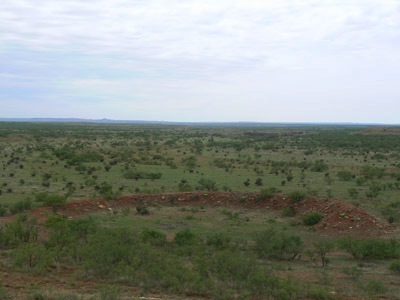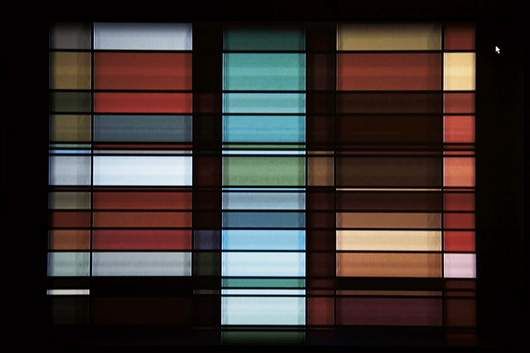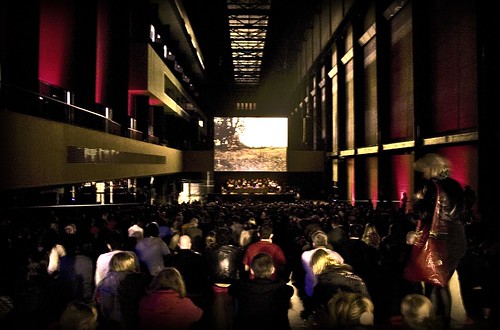These are the last two segments from the lecture I gave at the University of Utah School of Art in 2007, titled Visiting Artist [sic]. They’re both about Robert Smithson. The first [above] is about Smithson’s own 1972 slideshow lecture at the UofU, “Hotel Palenque,” which he also published as an Artforum article, and which his estate eventually sold to the Guggenheim as a multimedia installation piece of art.
I love “Hotel Palenque,” and took its irreverent challenge to the orthodoxy of art and art criticism as part of the inspiration for some of my own talk. In preparation for my own lecture, I tracked down some people who were present at Smithson’s original lecture, to see what the artist may have said or indicated at the time.
Unlike the Guggenheim, I am deeply unconvinced that the lecture is a work of art per se. But I find it useful asking how and why treat this thing [sic] an artist made/did/said differently depending on whether it is or isn’t Art.
The second clip is the hometown favorite, the Spiral Jetty. In 2007, the big questions surrounding the Jetty concerned its recognition as a tourist attraction. The state government decided to do a big cleanup of the industrial detritus and abandoned machinery on Rozel Point [they arbitrarily classified wood and stone structures as “historic,” while removing all metal.] And then Smithson’s widow Nancy Holt made offhand comments about how it’d be fine with Bob to rebuild the Jetty, because that wasn’t the kind of entropy he meant, anyway. So I riffed on what kind of entropy might be best for a once-obscure, once-abandoned, now-popular Earthwork.
All Visiting Artist [sic] posts:
Parts 2 & 3: On Dan Flavin
Parts 4 & 5: On Throwing Art Away
video of Part 6: On Joep van Lieshout, which I apparently didn’t post here
Parts 7 & 7 [sic] on Robert Smithson
Category: inspiration
Morris, Dunkelman, Humiston
Errol Morris is unfurling another fascinating investigation of a 19th century photograph on hit NY Times blog. Today, in part 2/5, he talks with author and Civil War historian Mark Dunkelman about a breakthrough in researching the life of Amos Humiston, who became famous as the Unknown Soldier who died at Gettysburg:
ERROL MORRIS: As you read the letters for the first time, did you feel that Amos was coming back to life?
MARK DUNKELMAN: Yes. My whole idea of him was changing because I knew nothing of his personality or his personal experiences during the war. He was sick on occasion during the war. He mentions his comrades caring for him like a brother. And he referred to his hands. He said they looked like bird’s claws. That was great stuff. That was the key to me. That was the key. He could speak again. He could be a living person again instead of a corpse in rigor mortis on the battlefield.
Artist Tattoos I Have Not Collected

The closest I’ve ever come to getting a tattoo was this one, a 1992 work by Felix Gonzalez-Torres. The artist first showed this motif, a circle of dolphins that looks like it could have come from the border of an ancient greek kylix, in his first exhibition at Andrea Rosen Gallery in 1990. In that incarnation, it was a rub-on transfer on the wall, and it looked positively classical among the now-classic-Felix paper stacks.
For a moment, it seemed like the dolphins were becoming almost a logo for Felix. He embossed them in a small paper stack edition, and printed them on a limited edition t-shirt for a show in Madrid. Then in 1992, they made their last appearance in his work, as a tattoo, as part of a year-end group show at Air de Paris.
“Tattoo Collection” was conceived with Lawrence Weiner, and AdP’s Jennifer Flay invited 30 artists, including Carsten Holler, Vito Acconci, Philippe Parreno, to submit tattoo designs. Since then Flay, along with gallerists Rosen, Giles Dusein, and Daniel Buchholz, have added more than 200 submissions to the project. Sounds like it’s high time for a book. Or at least a slideshow.
I didn’t want it then, but when I was curating a year-end group show at Exit Art in 2000-2001, and was showing work that challenged the traditional collecting model, Felix’s tattoo was the top of my list. Andrea was very encouraging, but I ultimately decided not to get the piece because, ironically, I was worried I couldn’t maintain it properly.
And since then, I’ve been proved right. I can barely get to the gym a couple of times/week, and the spot I’d chosen–on the top center of my back–is starting to get a little hairy. If I’d been asked to loan the piece to a show somewhere, I’d have to get a trainer and a waxer both. Too much pressure.
Holy Smokes, New Yorker Films Is Closed
I can’t believe it. New Yorker Films is closing after 43 years in the independent and foreign film distribution business. In the business? They were the business for decades.
When I was working the projection booth at International Cinema at BYU, it was New Yorker’s library I was soaking in. When I moved to New York, it was Dan Talbot’s Lincoln Plaza Theater [and the Angelika, which I discovered on its inaugural weekend during a senior year road trip] where I saw most everything since.
New Yorker was sold to Madstone Films in 2002, and that company pledged New Yorker’s library as collateral and then defaulted on the loan. The creditor, which may be Technicolor, initiated foreclosure proceedings last week. For the sake of the 500+ classic title library, at least, I hope it’ll get acquired by someone who knows Ozu from Oshima. For the sake of Dan Talbot and his colleagues, I can only hope for a soft landing and many thanks.
End of the Road for New Yorker Films [indiewire]
Kim’s Video To Reopen In Salemi, Sicilia
The first time I finally dared go into Kim’s video, I thought I was ready, so I asked why Blade Runner wasn’t in the Ridley Scott section. [Yes, son, back when I was a boy, we had to go all the way to St Marks to rent Blade Runner. Uptown both ways.] Anyway, the clerk scoffed, “Because it’s in the Douglas Trumbull section.”
Now the Times has an awesome story about how it came to pass that Kim’s entire collection of 50,000 films, passionately collected from around the world, will become the centerpiece of an art town being organized in an abandoned hilltop village in Sicily.
I count this as a huge win. I will go to Kim’s Salemi ten times before I ever even think of heading to the Village to rent a VHS tape.
La Dolce Video [nyt]
As Close To Immortal As We’ll Ever Get
“Writing fiction takes me out of time,” he explains. “I sit down and the clock will not exist for me for a few hours. That’s probably as close to immortal as we’ll ever get. I’m scared of sounding pretentious because anyone who writes fiction is saying, ‘Look at this thing I’ve written.'”
from Bill Katovsky’s 1987 profile of University of Arizona Teaching Assistant of the Year, David Foster Wallace, republished by McSweeney’s [via tmn]
I Shouldn’t Have Said Anything.
This morning I was buying a Diet Coke at the gas station, which forced the lady to get up from her chair by the radio.
“Arlo Guthrie! I didn’t even know he was still alive!”
“Really! You know who I’m always amazed to hear is still alive,” I said, trying to match both the tenacious age and the names’ quirkiness and rhythm as closely as possible: “Studs Terkel.”
Studs Terkel dies [chicagotribune]
Studs spoke at the Printers Row Book Fair in June [chicagopublicradio.org]
Well, I Remember The First Time I Visited The Spiral Jetty
Former NGA curator and Dia director Jeffrey Weiss writes about the state of Land Art in the latest issue of Artforum. His focus: T.S.O.Y.W., a 3-hour Earthworks road trip movie/installation by Amy Granat and Drew Heitzler shown in this year’s Whitney Biennial, and the Sculpture Center’s recent exhibition of feminism and Land Art in the 1970’s [which featured the Agnes Denes work, Wheatfield – A Confrontation in Battery Park City that I mentioned a couple of months ago.]
As Earthworks come of age, their fate has begun to look contingent and fragile. Those who are charged with caring for the sites are rightly doing what they can to forestall change; but a true poetics of Land art–given the very nature of the medium–must at least contend with the conflict between an ethic of preservation and the entropic pull of nature and culture that belongs to the content of the work. In this setting, Granat and Heitzler are melancholic visionaries. Their wheels, like reels, turn in order to draw a straight line and follow it: Their line is the road, a figure for unbounded space and inexhaustible time. But as their bike moves forward, their eyes gaze, historically, back; T.S.O.Y.W. shows us that memory has become a chief element of the temporal condition of the Earthwork. The film’s end is a running-down and out, a sudden shift from images of the infinite desert to scarred film leader, then, abruptly, to nothing at all. Forever turns out to be the ultimate conceit. [emphasis added]
Hmm, let’s ignore the conceit of a film ending abruptly while it’s actually screening on an endless loop in a gallery.
I’m intrigued by the idea that memory is a “chief element” of Land Art and its “temporal condition,” if it somehow equates to the divergence between the contemporary condition and experience of visiting the work/site and its various representations, whether in film, photograph, or documenting ephemera.
For most art audience members over the intervening decades–curators, critics, collectors and artists included– Land Art exists as books, photos, gallery presentations, and texts. At the Whitney’s Robert Smithson retrospective in 2005, one symposium panelist went so far as to argue that Spiral Jetty was primarily a film and photo work, as if the jetty itself were just a location, a bit of IMDb trivia. It sounded to me then like just the kind of critical reading that a New York art worlder would make who’d come of age when the Jetty was submerged, and who’d never bothered going to Utah in the 10+ years since it re-appeared.

With images and expectations formed in our head, actually visiting an Earthwork can be as disorienting as meeting your favorite NPR host. Or if, as Weiss points out, the work has deteriorated over time, it’s like meeting an author who hasn’t updated his bookjacket photo for a while. And the disconnect can be jarring; When Titus O’Brien made his pilgrimage to Smithson’s last work, Amarillo Ramp, he found the powerful sculptural form of the iconic 1973 photograph had become “a worn down, weed covered, neglected berm of dirt you’d just mistake for an old watering trough dam. A phantom.”

But memory is more than the gap between reality and what we think reality is; it’s the reconciliation and construction of the two. Weiss’s concerns about the complications Land Art curators face is right, but maybe not in the way he says. From Marfa to the Lightning Field to the Jetty to even Michael Heizer’s Double Negative and Turrell’s Roden Crater, the Earthworks Road Trip has matured in the last decade as both a real experience and a concept. As more people make the pilgrimages and have personal encounters with these works, not only do their memories of the works change, but other people begin to perceive the works not just as images in a book or on a wall, but as visitable sites.
I wonder how the perceptions and understanding of Walter deMaria’s Lightning Field change when they’re based, not just on John Cliett’s dramatic, official photos [via], but on firsthand accounts of the 24-hour visiting experience, very few of which appear to involve actual lightning? And how would that change if Dia and deMaria allowed visitor photographs? When it comes to Land Art in the present and future, there are still a few more conceits left to be addressed.
Waiting For Godot Times, Thursdays At 8, 9 Central
Daniel Birnbaum in Artforum, discussing “Beckett/Nauman,” a Spring 2000 exhibition at the Kunsthalle Wien
The organizers of “Beckett/Nauman,” Kunsthalle Wien curator Christine Hoffmann and art historian Michael Glasmeier, aren’t really out to prove anything, but their juxtaposition of works by the two artists provides ample ground for comparison and analysis of thematic affinities. This is not a major Nauman show in the ordinary sense, even if a number of important pieces–A Cast of the Space under My Chair, 1965-68, lots of videos, and two “corridors,” one shown for the very first time–are effectively installed. It’s not a major Beckett show either, for there’s no such thing. This is something else entirely: a gray inventory of impossible connections or an archive of discontinuities. It’s a genealogical space rather than a show. Full of detailed information–manuscripts, drawings, notebooks, and sketches–the exhibition piqued curiosity and made the viewer attentive. I liked it a lot.
Emphasis added on the part I liked a lot. But wait, there’s more…
Birnbaum makes the argument that Beckett and Nauman aren’t actually intergenerational inspirational source/recipient, but contemporaries. Did you know Beckett adapted a play for the BBC in 1977, and produced several teleplays and what must be considered video art pieces for TV as late as the Eighties? Here’s a clip of Quad I & II, a wordless experiment in rhythm and rulemaking created for the German broadcaster Süddeutscher Rundfunk. Come to think of it, yeah. When was Mummenschantz again? Oh, wait, I thought I was totally kidding.
Film, meanwhile was Beckett’s first and only film screenplay. 40 pages, comprising notes and diagrams around a “fairly baffling when not downright inscrutable six-page outline,” Becket wrote it in 1963 and shot it in New York in 1964. Film dealt with E and O [for Eye and Object, apparently] and “the question of ‘perceivedness,’ the angle of immunity, and the essential principle that esse est percipi: to be is to be perceived.” For 20 wordless minutes, a camera follows an aged Buster Keaton as he tries to avoid being seen.
Is Film online? Of course it is, thanks to UbuWeb. [There’s also a clip on YouTube.] Ubu also has director Alan Schneider’s account of making the film, where I got the quotes in the previous paragraph.
[thanks reference library]
The Sound Of One Hand Patting Itself On The Back
Just, wow. John Cage, Merce Cunningham, Louise Nevelson, and yet the sycophancy and superciliousness of this 1974 interview in SoHo by a couple of early Interview contributors is almost unwatchable. Almost. I just watched it again:
R. Couri Hay: My name is Couri Hay. Tonight Anton Perich and I are in SoHo, and we’re very privileged and happy to be at Louise Nevelson’s house where we’ve just had a fabulous extravaganza in black and white, a benefit. party for Merce Cunningham and his dance studio. We’re gonna hear–talk tonight with John Cage, who has done much of the fabulous avant-garde music for Merce’s work. And of course, in the middle, we have Louise Nevelson sculptress extraordinaire, and then, of course, Merce Cunningham, who I guess has been the star of the party.
Merce Cunningham: [laughing] Louise Nevelson has been the star of the party. Look at her! What more do you have to see?
Louise Nevelson: [talking over]
MC: What am I supposed to say, should I thank–
CH: No, no, just tell me: did you have a great time?
John Cage: [running interference] Everyone has been a star, we’ve had practically, what, 200 stars?
LN: We’ve had 200 stars, but some stars shine more than others.
And on it goes, for like 35 minutes. I listen to every Cage interview I can dig up, and I have never found one so content-free. I guess it’s good to be reminded of the social context in which even the people you revere had to work.
[via artforum/video]
The Codicil To John de Menil’s Will
In 2005, Robert Gober curated a show at the Menil Collection in Houston. In his catalogue, Robert Gober Sculptures and Installations, 1979-2007,” for the Schaulager show, Gober says, “Initially, I was only interested in curating from the collection and not including my own work, but when I began investigating the contents and the storage of the Menil Collection, I saw what [then chief curator] Matthew Drutt was already seeing. My work and the work in the collection shared affinities and themes. Catholicism, Surrealism, race, and a belief in the everyday object.”
The exhibition’s title, “The Meat Wagon,” comes from a codicil to John de Menil’s will. It’s awesome.
To my Executor
c/o Pierre M. Schumberger
I am a religions man deep at heart, in spite of appearances. I want to be buried as a catholic, with gaiety and seriousness.
I want the mass and last rites to be by Father Moubarac, because he is a highly spiritual man. Within what is permissible by catholic rules, and within the discretion of Moubarac, I want whoever feels so inclined to receive communion.
I want to be buried in wood, like the jews. The cheapest wood will be good enough. Any wood will do. I want a green pall, as we had for Jerry MacAgy. I would prefer a pickup or a flat bed truck to the conventional hearse.
I want the service to be held at my parish, St. Annes, not at The Rothko Chapel, because it would set a bad precedent.
I want music. I would like Bob Dylan to perform, and if it isn’t possible, any two or three electric guitars playing softly. I want them to play tunes of Bob Dylan, and to avoid misunderstanding, I have recorded suggestions on the enclosed tape. The first one, Ballad of Hollis Brown is evocative of the knell (nostalgic bell tolling). Then at some point Blowin’ In The Wind, The Times They Are A-Changin’ and WIth God On Our Side, because all my life I’ve been, mind and marrow, on the side of the underdog. Then Girl From The North Country to the rhythm of which the pall bearers would strut out of the church. Father Duploye could also be asked to sing Veni Creator in latin, to the soft accompaniment of a guitar.
I would like the funeral director to be Black.
I would like the pall bearers to be Ladislas Bugner, Francesco, Francois, Miles Glaser, Mickey Leland and Pete Schlumberger.
I would like George to stand with Dominique, Christophe, Adelaide, and Phil. Simone Swan, Helen Winkler, Jean Riboud, Ame Vennema, Rossellini and Howard Barnstone will be part of the family. Also Gladys Simmons and Emma Henderson.
I want no eulogy.
These details are not inspired by a pride, which would be rather vain, because I’ll be a corpse for the meat wagon. I just want to show that faith can be alive.
Date:NovemberDecember 13, 1972
/s/ John de Menil
The Rothko Chapel had only been dedicated in 1971. John de Menil died on June 1, 1973. His wife Dominique, who exerted a formative influence on my views of art in the times we met between 1990 and 1995, died in 1998.
Tibet Is Next To China

My daughter got Tibetan necklaces for Christmas when she was two. I asked her if she knew where Tibet was. And then I told her, “It’s next to China.”

image of Buddhist monks in Xiahe, Gansu province [in China] showing solidarity with protesters in Lhasa on the occasion of the 49th anniversary of the Tibetan rebellion against the Chinese invasion, which ended in the Dalai Lama’s fleeing the country: AFP/Getty via NYT.
Tibetan Government in Exile [tibet.com]
Angel Dust, 2000, Jeremy Blake

From “Jeremy Blake in Three Parts,” written by editor/curator Bennett Simpson for PS 1’s “Greater NY” show. In 2000, Blake’s 20-min. digitally animated abstraction titled Angel Dust was in both the harried, hasty “Greater NY” and the Pompidou’s “Elysian Fields”, a sublime show for which Simpson curated an incredible sound program:
I.
In the new art game, machine language is the best kind of pragmatism. Because you’ve never had so many options, your tools should work for you. There is still such an impoverished discourse around art made with “new media” that it benefits everyone to be dexterous (or at least flexible). Jeremy Blake tells me it took months to program his latest digital animation Angel Dust. I believe him. Line for line, the amount of coding, sequencing, and editing involved is staggering. As is more and more the case with art’s flirtation with technology, the hours logged and the efforts involved are right on the surface — and in a way, this is part of the point. Skill is transparent. Insofar as Angel Dust can be called abstract art, its abstraction is one of trial and error, micro-production, shortcuts, good fortune, lots of practice, lots of knowledge, and an appreciation of possibilities. I’m not only speaking about the animation’s formal qualities or its methods of production. If abstraction is now the domain of distributed and integrated systems of information, then the function of Angel Dust’s content — its seething Mondrian grid, its Burbank-rolled narrative tics, and its psychedelia — is no different from its code. Blake makes programmed art works: the what and how are symptomatic of each other.
The other two parts are after the jump. An edition of Angel Dust is coming up at auction at Phillips in a couple of weeks.
Derek Jarman’s Blue and Travelex’s Pink
In 2000 curator Scott Burnham organized a projection of Derek Jarman’s last film, Blue, on the facade of the National Theatre. Visually, the film consisted of a monochrome, electric blue inspired by Yves Klein. The audio, which included readings of Jarman’s journals, was broadcast via localized, low-frequency radio.
The photo on the right was from 2007. After the successful proof of concept, the National Theatre could get down to business.
Derek Jarman’s In The Shadow Of The Sun
I’ve had Derek Jarman on the brain the last couple of weeks. Isaac Julien’s spectacularly moving documentary Derek got distribution at Sundance and won awards at Berlin; Julien’s curated show of Jarman’s work opened at the Serpentine.
And I found photo accounts of a live performance of Throbbing Gristle’s live accompaniment of Jarman’s super-8 shorts, In The Shadow of The Sun, last fall in the Turbine Hall at Tate Modern. [above].
TG provided the original soundtrack in 1980-81. They played to a packed house last May as part of the Tate’s Long Weekend series of events and performances. If you liked Throbbing Gristle’s kind of assaultive ambient 80’s music, this was the kind of assaultive ambient you liked. They apparenty provided cushions, since no one who listened to TG back in the day likes to sit on cold, concrete floors anymore.


